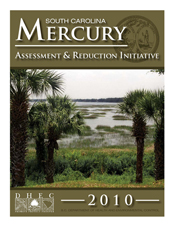
The S.C. Mercury Assessment and Reduction Initiative , published in 2010, discusses assessment, monitoring and reduction efforts and recommends actions to accomplish those and other related goals.
For information on how you can help to reduce mercury in the environment, please visit our Web page .
Fish
Mercury in South Carolina fish has been generally decreasing over the last 15 years. Many areas of the state continue to have fish consumption advisories .
The S.C. Mercury Assessment and Reduction Initiative , published in 2010, discusses assessment, monitoring and reduction efforts and recommends actions to accomplish those and other related goals. View pages 51 and 52 for information on mercury in fish.
Air and Water
South Carolina air and water are safe for normal activities with respect to mercury. Air and water in the state contain some mercury, as is true across the nation and around the world. The mercury in South Carolina air transfers to water bodies, where the mercury risk in fish can accumulate at levels thousands of times higher than the surrounding water concentrations. However, the general air and water mercury levels in South Carolina are low and considered safe for normal activities (breathing the air, drinking and swimming in the water). The general mercury levels in South Carolina air and water are tracked by DHEC through air monitoring stations and surface water sampling activities. Please read The S.C. Mercury Assessment and Reduction Initiative (pages 27-52) for more information.
Air Emissions and Deposition
In comparison to other states, South Carolina does not release high levels of mercury. South Carolina ranks in the middle range of states in amount of mercury air emissions. South Carolina, along with other eastern states, appears to receive more mercury in rain and snow than many of the western states. Please see The S.C. Mercury Assessment and Reduction Initiative (page 31) for a map of nationwide mercury deposition.
Hot Spots
South Carolina has some areas in the state that naturally speed up bioaccumulation in fish tissue, resulting in "hot spots" of contamination for some fish species. These water bodies in the Pee Dee and Edisto areas (often called "blackwater" streams, rivers and swamps), possess natural characteristics that convert more mercury to methylmercury (the highly toxic form of mercury that bioaccumulates in fish). This results in greater bioaccumulation and higher fish tissue levels in these areas. Some examples of the natural characteristics of these water bodies include lower pH and higher total organic carbon levels. Please read The S.C. Mercury Assessment and Reduction Initiative (beginning on page 53) for more information on hot spots.